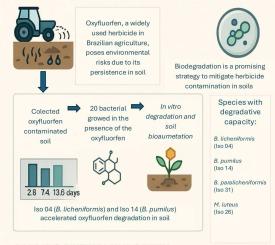Selection of microbial isolates for oxyfluorfen degradation in soil
IF 11.3
1区 环境科学与生态学
Q1 ENGINEERING, ENVIRONMENTAL
引用次数: 0
Abstract
Brazilian agriculture is a key sector for economic development and food security; however, the intensive use of herbicides, particularly oxyfluorfen, has raised environmental concerns due to its persistence in soil. Microbial biodegradation represents a sustainable and promising alternative for mitigating such impacts. This study aimed to: select microbial isolates from soils with a history of oxyfluorfen application capable of surviving in media containing the herbicide; evaluate their oxyfluorfen degradation potential in vitro; identify biochemical markers associated with degradation efficiency; assess the degradation performance of selected isolates in soil via bioaugmentation; and identify the most efficient isolates at the species level. From 35 isolates, 20 demonstrated growth in the presence of oxyfluorfen. Among these, 65% were Gram-positive Bacillus spp., with 50% forming endospores; the remainder included Gram-positive cocci and yeasts. Multiple correspondence analysis of biochemical profiles did not clearly distinguish isolates by degradation capacity. However, isolates 14 and 4 showed superior performance, degrading 40% of the herbicide in 2.8 and 7.4 days (100 mg kg⁻¹), and 9.8 and 13.6 days (200 mg kg⁻¹), respectively. The most effective strains were identified as Bacillus licheniformis, Bacillus pumilus, Bacillus paralicheniformis, Micrococcus luteus, and Moesziomyces aphidis, the latter reported here for the first time.

土壤中羟氟醚降解微生物分离物的筛选
巴西农业是经济发展和粮食安全的关键部门;然而,除草剂,特别是氟氧醚的大量使用,由于其在土壤中的持久性,引起了环境问题。微生物生物降解是减轻此类影响的一种可持续和有前途的替代方法。本研究旨在:从施用过氟氧芬的土壤中选择能够在含有该除草剂的培养基中存活的分离微生物;评价其在体外对羟氟醚的降解潜力;识别与降解效率相关的生化标记;通过生物强化技术评估选定菌株在土壤中的降解性能;并在物种水平上确定最有效的分离株。在35株分离株中,20株在氟氧芬存在下生长。其中65%为革兰氏阳性芽孢杆菌,50%形成内生孢子;其余包括革兰氏阳性球菌和酵母。生化谱的多重对应分析不能明确区分菌株的降解能力。然而,分离株14和4表现出更好的性能,分别在2.8和7.4天(100 mg kg⁻¹)和9.8和13.6天(200 mg kg⁻¹)内降解40%的除草剂。其中地衣芽孢杆菌、细粒芽孢杆菌、副衣芽孢杆菌、黄体微球菌和蚜虫莫兹菌效果最好,其中后者为首次报道。
本文章由计算机程序翻译,如有差异,请以英文原文为准。
求助全文
约1分钟内获得全文
求助全文
来源期刊

Journal of Hazardous Materials
工程技术-工程:环境
CiteScore
25.40
自引率
5.90%
发文量
3059
审稿时长
58 days
期刊介绍:
The Journal of Hazardous Materials serves as a global platform for promoting cutting-edge research in the field of Environmental Science and Engineering. Our publication features a wide range of articles, including full-length research papers, review articles, and perspectives, with the aim of enhancing our understanding of the dangers and risks associated with various materials concerning public health and the environment. It is important to note that the term "environmental contaminants" refers specifically to substances that pose hazardous effects through contamination, while excluding those that do not have such impacts on the environment or human health. Moreover, we emphasize the distinction between wastes and hazardous materials in order to provide further clarity on the scope of the journal. We have a keen interest in exploring specific compounds and microbial agents that have adverse effects on the environment.
 求助内容:
求助内容: 应助结果提醒方式:
应助结果提醒方式:


